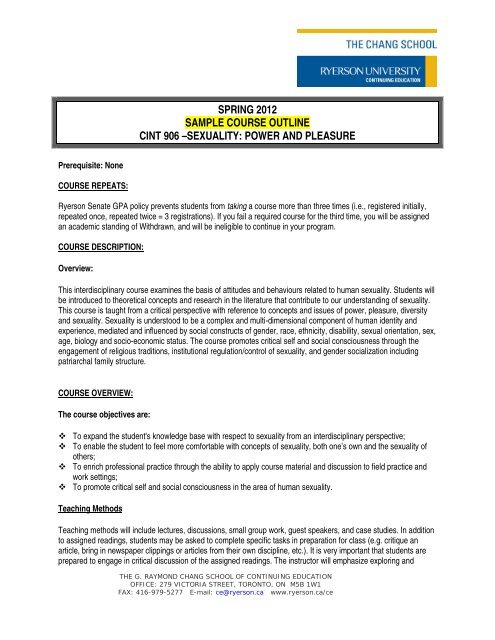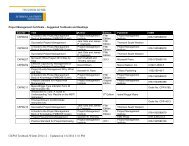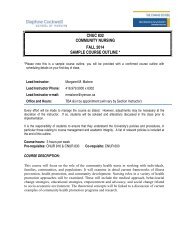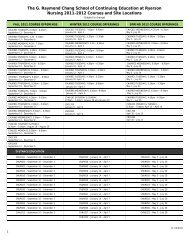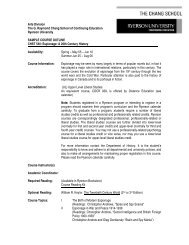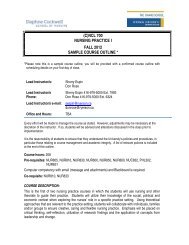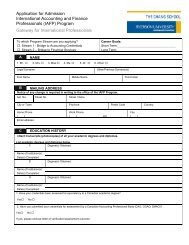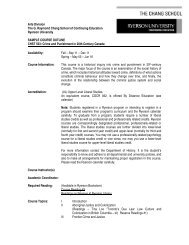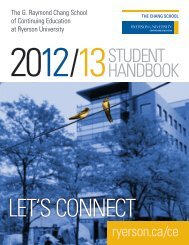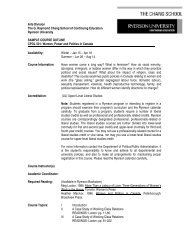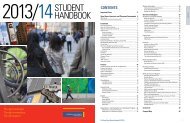CINT 906 - The Chang School
CINT 906 - The Chang School
CINT 906 - The Chang School
Create successful ePaper yourself
Turn your PDF publications into a flip-book with our unique Google optimized e-Paper software.
SPRING 2012SAMPLE COURSE OUTLINE<strong>CINT</strong> <strong>906</strong> –SEXUALITY: POWER AND PLEASUREPrerequisite: NoneCOURSE REPEATS:Ryerson Senate GPA policy prevents students from taking a course more than three times (i.e., registered initially,repeated once, repeated twice = 3 registrations). If you fail a required course for the third time, you will be assignedan academic standing of Withdrawn, and will be ineligible to continue in your program.COURSE DESCRIPTION:Overview:This interdisciplinary course examines the basis of attitudes and behaviours related to human sexuality. Students willbe introduced to theoretical concepts and research in the literature that contribute to our understanding of sexuality.This course is taught from a critical perspective with reference to concepts and issues of power, pleasure, diversityand sexuality. Sexuality is understood to be a complex and multi-dimensional component of human identity andexperience, mediated and influenced by social constructs of gender, race, ethnicity, disability, sexual orientation, sex,age, biology and socio-economic status. <strong>The</strong> course promotes critical self and social consciousness through theengagement of religious traditions, institutional regulation/control of sexuality, and gender socialization includingpatriarchal family structure.COURSE OVERVIEW:<strong>The</strong> course objectives are: To expand the student's knowledge base with respect to sexuality from an interdisciplinary perspective; To enable the student to feel more comfortable with concepts of sexuality, both one’s own and the sexuality ofothers; To enrich professional practice through the ability to apply course material and discussion to field practice andwork settings; To promote critical self and social consciousness in the area of human sexuality.Teaching MethodsTeaching methods will include lectures, discussions, small group work, guest speakers, and case studies. In additionto assigned readings, students may be asked to complete specific tasks in preparation for class (e.g. critique anarticle, bring in newspaper clippings or articles from their own discipline, etc.). It is very important that students areprepared to engage in critical discussion of the assigned readings. <strong>The</strong> instructor will emphasize exploring andTHE G. RAYMOND CHANG SCHOOL OF CONTINUING EDUCATIONOFFICE: 279 VICTORIA STREET, TORONTO, ON M5B 1W1FAX: 416-979-5277 E-mail: ce@ryerson.ca www.ryerson.ca/ce
discussing ideas presented. Any alterations in course assignments, due dates, or marking schemes, as they appearin the outline, will be discussed prior to being implemented.TEXTS & READING LISTS:Reprotext. Original by Steinhouse, Karol, editor (1999) adapted by Marucci, Lisa (2008) Politicsof Sexuality: Power and Pleasure <strong>CINT</strong> <strong>906</strong>E-MAIL ACCOUNTS:Students are required to activate and maintain a Ryerson Matrix e-mail account. This shall be the official means bywhich you will receive university communications. See http://www.ryerson.ca/senate/policies/pol157.pdf.Student emails will be returned within three academic days. Emails on the weekend will be returned at the beginningof the week. All students are expected to compose emails in a professional manner. Messages using excessiveinternet abbreviations will not be answered.All students are expected to use their Ryerson email address for all communications with their instructor.EVALUATION:Student Evaluation1. 15% Interdisciplinary Group Social Analysis (week after course)2. 20% Interdisciplinary Group Presentation (week after course)3. 35% Term Paper Due (approximately one month)4. 15% Journal Due (two weeks after course)5. 15% Participation (students assigned to readings to facilitate class discussion, attendance, interactingwith class discussion, demonstrating attentiveness to class discussion, evidence that the material has beenread for class, completion of the group work assessment form and as evidenced by the depth of the journalassignment )1. Interdisciplinary Group Social Analysis 15%Objectives:‣ to constructively work within an interdisciplinary group in order that the unique perspective of eachdiscipline can be appreciated and commonalties and differences between disciplines explored;‣ to provide an interdisciplinary perspective on our social context;‣ to bring into consciousness the societal discourse related to sex, sexuality, and gender and criticallyevaluate;‣ to creatively document the process.A successful social analysis will be one that demonstrates the commonalties and the differences of each disciplinesperspective in a social space. Discourses of sex, sexuality, and gender will be discussed to make explicit thediscourse from each person’s perspective. <strong>The</strong> group will then critically evaluate the discourse. Agreement betweengroup members is not essential. However, each group member must be given the opportunity to express their ownunique analysis and how this relates to their own discipline. Group members should be open to experiencing thechallenge of views different from their own.2
Documentation must include the following for each social space:‣ group members in attendance and their discipline;‣ a description of each social space;‣ a point form list of the discourse observed;‣ observations of the commonalties and differences between the disciplines’ perspectives.2. Interdisciplinary Group Presentation 20%Objectives:‣ to choose a social issue related to the course topic and problem solve from an interdisciplinary perspectivehow you can begin to create social change;‣ to strategize on both a micro and a macro level how the process of change can occur;‣ to creatively brainstorm radical approaches to the issue and evaluate the feasibility of the plan;‣ to present to the class an explanation of the chosen social issue and the plan as devised by the group;‣ facilitate a class discussion on the issue and the plan.A successful group presentation will creatively present the social issue and the salient points of concern. <strong>The</strong>presentation will demonstrate each discipline’s contribution to the resolution of the issue. Any points of inherentconflict between disciplines will be presented and if possible, the group will suggest a possible approach to workingfrom a collegial interdisciplinary perspective. <strong>The</strong> presentation will provide an opportunity for the class to participatein the discussion and development of a plan for social change.Each group will present to the class a total of 40 minutes including discussion. Each group member will be assigneda group grade.<strong>The</strong> intent of this assignment is to provide the opportunity to work from an interdisciplinary perspective on a realsocial issue. A serious exploration of this assignment will create natural tensions and struggles. Students will need toapproach the assignment in a respectful and professional manner. Group consensus may not be possible on allpoints. In the presentation, these points of tension are as important as the points of agreement.3. Final Term Paper 35%<strong>The</strong> paper requires that you:‣ Review the literature;‣ Analyze relevant theoretical and practical issues;‣ Integrate issues of race, gender, sexual orientation and other sites of difference into your paper;‣ Integrate personal experiences and reflections (optional);‣ Demonstrate critical thinking through analysis of material. Draw on relevant course reading anddiscussion;‣ Bring in an interdisciplinary perspective by providing a breadth of material.NOTE: Please refer to the Assignment Evaluation Guide in developing your assignment. (Appendix B)3
Expectations for Essay:‣ 8-10 sources minimum, including a selection of journal articles.‣ Length: 8 -10 pages (250 words/page) excluding references and title page, typed, double-spaced.‣ APA format4. Journal Assignment 15%Objectives:Nature of Journal:‣ to provide a vehicle for reflection of personal thoughts, feelings and values regarding sexuality;‣ to encourage connections between your own experience and larger patterns (consider impact ofculture, gender, religion, race, class, sexual orientation, disability, and social institutions).<strong>The</strong> personal journal is a record of your thoughts, feelings and experiences as they occur during and after class.Write about your feelings, your observations of yourself and others, insights into your thinking and that of yourclassmates. Set aside the time for quiet reflection and journal writing. This personal journal assignment is meant tobe a tool for your own use. It is a record of what happens for you throughout the course. Record specificobservations, impressions, thoughts and feelings. Allow this to be a free-flowing journal focusing on self- expressionnot style. Link your thoughts and insights, when appropriate, to your reading and to your experiences. Patterns andmeanings will emerge as classes go by; it is not necessary to understand everything that occurs, but it is important towrite your impressions into your journal for later review, reflection and understanding.Journal entries should include the following:1. Integration of readings and reflections. You are free to select additional readings (bibliography, etc.). It isyour analysis and attempts at integration that the instructor is interested in. You are encouraged tochallenge the readings in your analysis and, in the event of disagreement, supply your rationale for yourdisagreement.2. Learning and insights drawn from the material covered and/or the experiences to which you have beenexposed.3. Ideas that strike you as being of some importance from each of our classes. Questions generated by thework in class as well as your attempts to find answers to the questions.4. Feelings that have been generated by the various experiences throughout the class.Required Format:‣ Legible hand-written notes are satisfactory.‣ Hand in journal in lightweight binder or notebook with all entries together.‣ Suggested length: Write every night at least 2 pages per day for a total of 8 pages. <strong>The</strong> length should not beas important as the content. You must be the judge of how big/small that you write. As long as your entriesinclude the above four factors you have done the assignment.Please do not focus so much on length as much as ensuring that you put your self (thoughts, feelings, andexperiences) into this work.4
JOURNAL WILL BE KEPT CONFIDENTIAL. PLEASE INCLUDE A SELF-ADDRESSED STAMPED ENVELOPE TOHAVE IT RETURNED. SHOULD YOU CHOOSE NOT TO HAVE IT RETURNED THE DOCUMENT WILL BESHREDDED.PLEASE READAll e-mailed assignments MUST include the assignment pasted into the body of the e-mail. If this is not done and Iam unable to open the attachment, the assignment will be considered late.Late Policy:Late assignments will be downgraded 5% per day.A request for an extended deadline for an assignment will be given only on medical or compassionate grounds. If arequest for an extension is required, a written Request for an Extension Date must be submitted before the due date.All assignments must be handed in to the professor in class on the day it is due. If not possible, it is yourresponsibility to make alternative arrangements. If you are unable to be at class to pick up an assignment pleaseinclude a self addressed stamped envelope. Assignments left following the end of term will be shredded.Due to the intensive nature of this course it is not possible to return papers in person to students. If you would likeyour assignments returned you MUST provide a self addressed stamped envelope. If you do not provide this yourpaper will be shredded.TOPICS – SEQUENCE & SCHEDULEThis schedule includes preliminary presenters, readings assigned, and a very rough overview of material to becovered in class. A final schedule will be distributed the first day of class. Please ensure you plan to be at the schoolbetween 9-5:00pm daily.Day 1 Introduction‣ Course objectives‣ What’s interdisciplinary studies?‣ Course requirements‣ Terminology‣ Good sex – Bad sex‣ <strong>The</strong>oretical Perspectives‣ Intersexuality‣ Sexability Program Presentation: Anne Johnston Health CentreRead Articles #1 - #55
Day 2‣ Identity – How do you identify?‣ Gender – Male, Female, Other?‣ Sexual Orientation‣ Adolescent Sexuality and Current STI’s: Lyba Spring, Toronto Public HealthRead Articles #6- #11Day 2‣ Orgasm Controversies‣ Sexual Abuse‣ Sexual Development‣ Group Work‣ Good For Her Presentation: TaraRead Articles #12 - #19Day 3‣ Race, Culture, and Ethnicity‣ Sex in the City: Carlysle Jansen, Good For Her‣ Will Rowe and Samantha Lauzon: Trans IssuesRead Articles #20 - #23Day 4‣ Spirituality and Sexuality‣ Presentations by Students‣ Red High Heels (to be explained in class)Day 5TBAAcademic JournalsJournal Titles Ryerson Library Ryerson Library Electronic Access (2)LC Call No. (Full- Text)AdolescenceHQ/793/.A44Archives of Sexual BehaviourHQ/I/.A47 (UofT)6
Canadian Journal of Human SexualityContemporary Family <strong>The</strong>rapyHQ/56/.AI/C3RC/488.5/.AIO6Families In Society HV/l./F35 ProQuestFamily Life EducatorFamily ProcessHQ/I./F36RC/488.5/.AI/F3Hypatia HQ/IIOI.H96 CWI/ProQuestInternational Journal of Adolescence& YouthInternational Journal of Sociology ofthe FamilyJournal of Comparative Family StudiesHQ/796/.AI/I68HQ/I/.153HQ/I/.J44Journal of Family Issues HQ/I/.J463 EBSCO/ProQuestJournal of Family ViolenceJournal of HomosexualityHQ/809/.AI/J68HQ/75/.J68Journal of Marriage & the Family HQ/I/.J85 ProQuestJournal of Psychology & Human SexualityJournal of Sex Research n/a EBSCO/ProQuestJournal of Social Work & HumanSexualityHV/4I/.AI/J595Journal of Youth & Adolescence HQ/796/.AI/J68 ProQuestSex Roles: A Journal of ResearchSignsSociological ReviewSociology and Social ResearchHQ/IO75/.AI/S49HQ/IIOI/.S5HM/I/.S5HM/I/.S72Women's International Network HQ/IIOI/.W763 EBSCOWomen's Studies International ForumYouth & SocietyJournal of Men’s StudiesGay and Lesbian ReviewGender and DevelopmentSexualitiesAnd many, many others.HQ/IIOI/.W775HQ/793/.Y6n/a(I) Journals available on the 5th floor of the Ryerson Library.(2) Electronic Access via Library Home Page http://www.ryerson.library.ca7
Web SitesAlan Guttmacher InstituteCanadian Gay and Lesbian ArchivesCDC National AIDS ClearinghouseCoalition for Positive SexualityInternational Planned Parenthood FederationNational Coalition Against Sexual AssaultPlanetOutRoeher InstituteSexuality Issues/Safer Sex Condoms and LatexSIECUSTransgender Forum & Resource Centerhttp://www.agi-usa.org/http://www.web.net/archives/http://www.cdcnac.orghttp://www.webcom/com/~cps/http://www.ippf.org/http://www.ncasa.orghttp://www.planetout.comhttp://www.indie.ca/roeherhttp://www.empharm.uest.edu/~troyerlsafesex/condoms.htmlhttp://www.siecus.orghttp://www.edspub.com/tgfrc.htmlTERM PAPER EVALUATION GUIDEStudent:Course:Topic:Date:1. 10/35 Presentationa. Format: e.g., cover page, headings, neatness, margins recognized system for references;b. Bibliography;c. Writing skills: e.g., grammar, spelling, punctuation, word usage;d. Writing Style: e.g., clarity and conciseness, style, flow, etc.2. 5/35 Organization & Structurea. Introduction with clearly stated objectives relevant to the goals of the assignment;b. Logical sequence;c. A concluding section has summarizing thesis.3. 10/35 Literature Reviewa. Selection of relevant books, articles;b. Synthesize key points;c. Compare/contrast themes;d. Critique readings;e. Demonstrate interdisciplinary breadth.4. 10/35 Discussion & Analysisa. Critical analysis of material;b. Develop your own point of view of material;8
c. Self-reflection as it relates to material;d. Substantiate conclusions.Comments:9


